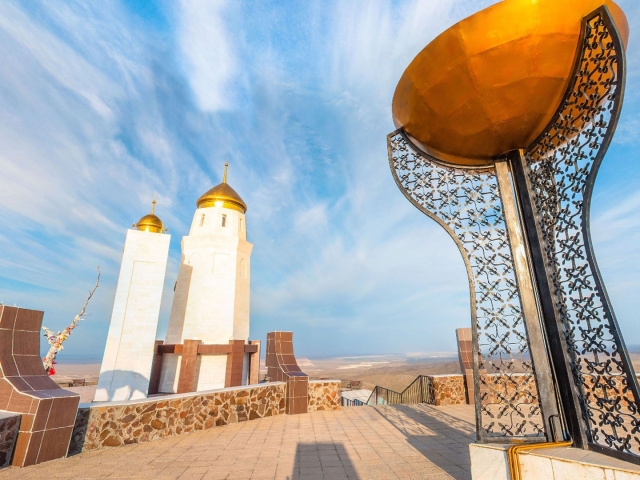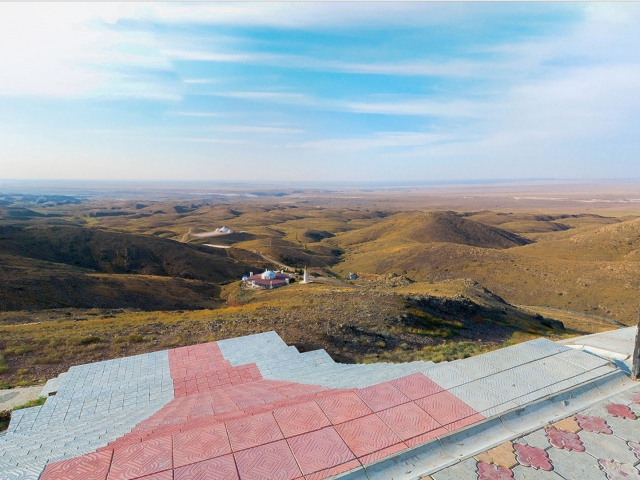Places
List of objects included in the map
Otpan Tau Historical and Cultural Complex
Location: Located in Mangistau district of Mangistau region, 15 km to the east from the village of Zhyngyldy.
Coordinates: N 44°11' 27.45" , E 51°53' 17.58"
Description of the Monument: The author of the idea and scientific concept for construction of the spiritual complex Otpan is a well-known poet and public figure Sabyr Aday. In 2004 he designed the historical and cultural complex, and designer and architect Kopbol Demessinov constructed it. October 25, 2007 the mausoleum was opened. It is currently included in the list of national historical and cultural monuments of local value by Order no. 3 dated January 5, 2018 by Mangystau Regional Akimat . This memorial was included into the list of sacred objects as part of the project of regional importance Geography of Sacral Paces in Kazakhstan within the program 'Spiritual Renewal'. Historical and cultural complex Adai Ata - Otpan Tau includes a series of monuments in the open air:
Adai Ata Mausoleum. Aksaray – 37-meter-high white stone mausoleum dedicated to our ancestor Adai Ata and his two sons: Kalimberdy and Kudaike. The mausoleum consists of eight rooms devoted to eight grandchildren of Adai Ata. There is a History Museum showing the past life of the region;
Monument Image of a Mother. The wife of Adai Ata is an image of all mothers. The image of a mother is complemented with the moon - a symbol of the face, the sun is the heart, two eagles representing two sons, to whom mother passes the best human qualities - love of freedom, solidarity, fraternity. The two kids delivered by the mother are Kudaike and Kelimberdy. The mother is the cradle of life and progenitor of life, keeper of the hearth. Therefore this monument is located near the mausoleum of Adai Ata. The height of the monument is 15 meters;
The ladder of 362 stairs – walking path of 362 stairs which is the number of holy places in the region, leading to the top of Otpan Tau mountain;
Tamga of the Adai clan. On the shield a spear and a sword are depicted, in the center there is the famous tamga of Adai clan - an arrow pointing up which symbolizes courage, the country and unity.
The sculpture of 'Celestial Wolf' - animal totem, according to the legend, it is the ancestor of the Turkic people. Kokbori – the Great she-wolf, symbol of strength and freedom of spirit. According to the legend, she raised the baby she found - the future batyr;
'Fire of Unity' – symbol of independence. A monument with a huge torchlight bowl, where every year on the Amal feast sacred fire was ignited; it symbolizes the unity of three zhuzes – senior, middle and junior. It is located at the highest geographical point of Mangistau – 532 m above sea level. During 11 years on the Otpan mountain on the night of the 14th of March, the day of Nauryz celebration in Mangystau - Amal, which originates from the era of nomads, the Fire worshiping ancestors ignites (Tagzym Alauy). Traditionally the torch is passed on the baton to representatives of the Adai clan.
Historical Data, Legends and Stories: Adai Ata is a historical figure who played a prominent role in formation of the Kazakh people. According to the pedigree, the union of the 8 tribes of Adai clan descend from Adai Ata. The story of the origin of Adai Ata dates back to the 15th century. He died on the hands of the youngest grandson Munal. That is why Munal clan is considered master of the hearth and with special veneration they are called 'Munal's hearth'. 'Munal's hearth' is located in the southern part of the Kazygurt mountains and those in the know treat him with honor as a holy place. Kosai tribe is one of the largest and most numerous of Adai clan. Writer A. Kekilbayev notes that Adai ruled for 14 years, from 1435 to 1449. It is mentioned in historical sources by I. Trofimov and Aness Sarai. The wife of Adai Ata was Zhanar - the girl of a rich man named Zhantasa. Zhanar delivered Kudaike and Kelimberli. Many genealogical sources tells about the origin of Adai Ata that the father of the Adai was Yeltai and his mother was Kanbibi.
Otpan Tau is a mountain peak where signal fire was set up in case of impending danger to alert local people about the threat of attack. The flame on top of Otpan Tau is visible from any point. Clan rulers gathered on Otpan Tau for discussion and solving important matters for the people's destiny. The elders and sages sent warriors to the battle from here.
Currently the monument Otpan Tau attracts the residents of Mangistau, and neighboring Republics (Russia, Turkmenistan, Uzbekistan).
Sources:
- Encyclopedia Mangystau,
Almaty, 1997;
- Life Patterns by S.
Abishuly, Almaty, 2002;
- Archives of Mangistau National Historical
and Cultural Reserve.
Views: 5423
Video
Маршрут
Hazret Yerzhan Burial
Shopan Ata Necropolis and Underground Mosque
Shakpak Ata Necropolis and Underground Mosque (14th–19th centuries)
Khatam-Ishan Mausoleum
The earliest structures here date back to the second half of the 17th c. The necropolis was developed in time and space in a circle, i.e. the most ancient constructions remained in the center. Out of the two extant domed mausoleums, the structure in the southern part of the necropolis is of particular interest. ...























